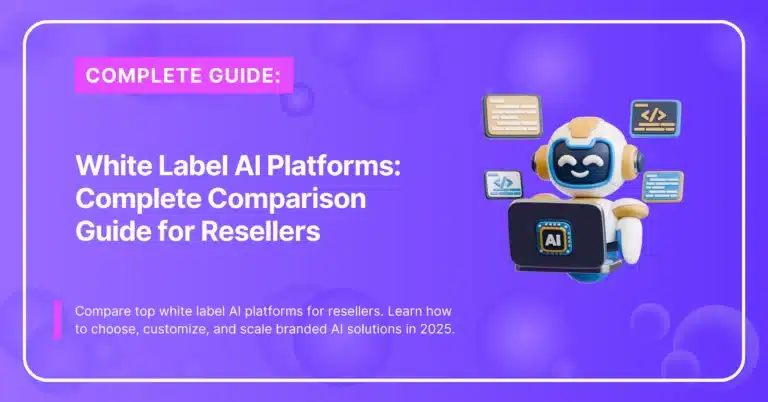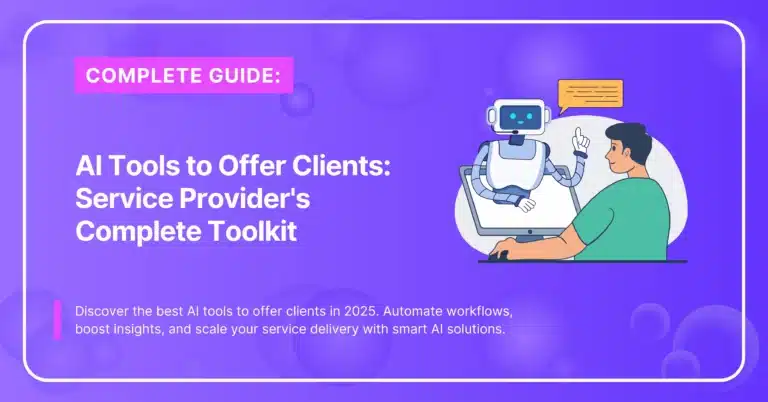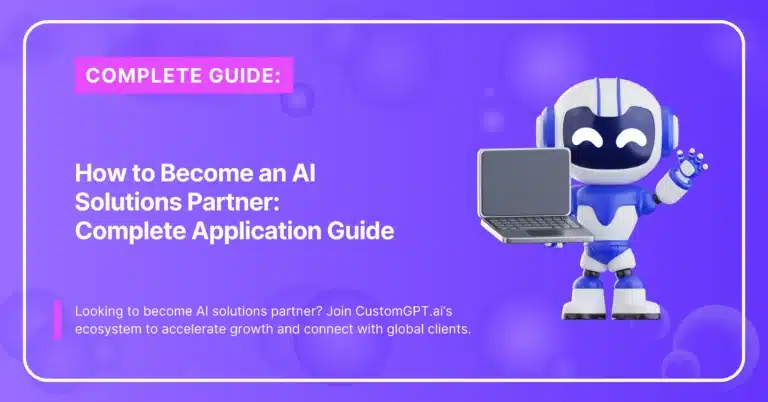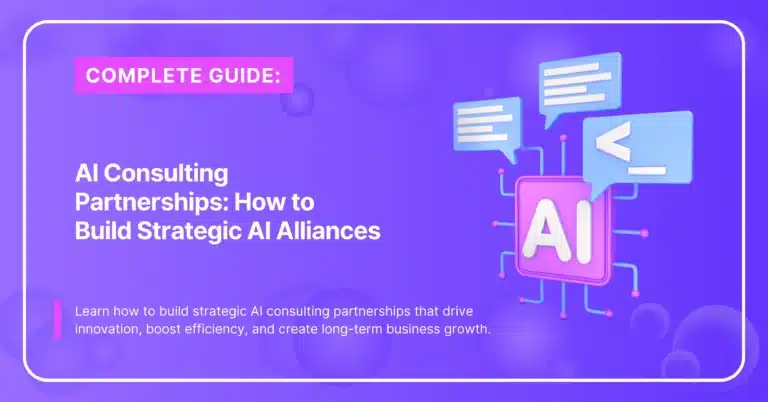AI has officially gone mainstream. In 2025, global spending on AI is expected to hit $360 billion, as organizations race to automate processes, unlock insights, and gain an edge in competitive markets.
But here’s the reality: without effective AI implementation, most of that investment is at risk.

Make Money With AI
Join our Partner Programs!
Boost your reputation, drive revenue and grow your business with CustomGPT.ai.
Research shows that over 80% of AI initiatives fail to deliver their intended results, often stalling after the proof-of-concept stage.
Think about that for a moment: billions are being poured into projects that never get beyond pilot mode. The reasons aren’t mysterious—data pipelines aren’t ready, objectives aren’t clear, and teams aren’t aligned.
The good news? These failures are avoidable. The organizations that succeed aren’t necessarily the ones with the flashiest algorithms or the biggest budgets—they’re the ones that invest in AI implementation support.
With the right guidance, they turn big AI ambitions into projects that actually deliver measurable outcomes.

Defining AI Implementation Support and Business Value
When people talk about AI, the conversation often jumps straight to the technology — models, parameters, or the latest breakthrough in generative AI.
But for organizations, the real story isn’t about the math inside the machine. It’s about how well the system is implemented, supported, and aligned with business goals.
That’s what AI implementation support delivers. It’s the professional services layer that ensures your AI project doesn’t just launch — it scales responsibly, creates measurable outcomes, and keeps improving.
What Is AI Implementation Support?
AI implementation support combines technical expertise, governance frameworks, and change management services to help organizations:
- Translate AI goals into measurable business outcomes.
- Manage integration challenges like data pipelines and workflows.
- Provide ongoing monitoring, retraining, and optimization.
Why It Matters
The business value of AI comes not from the algorithm itself, but from turning insights into action. For example:
- A churn-prediction model that sits in isolation = interesting but unused.
- The same model embedded into your CRM with alerts for account managers = real value.
The difference? Implementation and support.
Contextual Fine-Tuning as a Game-Changer
Generic models understand language broadly, but not the specifics of your industry or operations. With proper implementation support, AI can be fine-tuned to your environment. This makes outputs more accurate and decisions more reliable.
AI’s business value comes from:
- Relevance: tuned to your workflows and industry.
- Reliability: backed by governance and compliance frameworks.
- Results: measurable improvements like cost savings, efficiency, or compliance gains.
Key Concepts: AI Maturity and Governance
Many AI projects stall not because the model is weak, but because the organization isn’t ready to manage it at scale. That’s where AI maturity and governance come in.
They form the backbone of successful AI delivery, ensuring projects are ethical, compliant, and sustainable.
What Is AI Maturity?
AI maturity reflects how well an organization can deploy, monitor, and scale AI responsibly. Signs of maturity include:
- Clear strategy linking AI projects to business objectives.
- Strong data practices — integration, quality, and governance.
- Cross-functional collaboration between technical and business teams.
- Ability to retrain and optimize models as conditions change.
Organizations that invest in maturity see faster adoption and higher ROI.
Why Governance Matters
Governance isn’t bureaucracy — it’s what makes AI usable and trustworthy. A governance framework defines:
- Transparency: clear documentation of models and data sources.
- Accountability: who owns decisions and outcomes.
- Compliance: alignment with evolving laws and standards (e.g., EU AI Act, GDPR).
- Risk management: processes for handling bias, drift, or performance failures.
Without governance, even the most advanced model can create compliance risks or reputational damage.
AI maturity and governance go hand in hand. Maturity ensures readiness to scale; governance ensures trust and accountability. Together, they create the conditions for AI projects to succeed long after the initial rollout.
Strategic Planning for AI Projects
Even with strong governance, many AI projects fail because they weren’t scoped or prioritized correctly. Strategic planning ensures initiatives are tied to measurable business outcomes and have a clear path to delivery.
Why Strategy Matters
AI succeeds when it solves real problems, not when it’s deployed for novelty. Strategic planning connects AI to outcomes like:
- Reducing operational costs.
- Improving compliance accuracy.
- Enhancing customer satisfaction.
- Streamlining workflows.
Using a Value vs. Complexity Matrix
Not all AI projects deliver equal impact. The value vs. complexity matrix helps organizations prioritize:
- High value, low complexity: Quick wins such as AI chatbots for customer service.
- High value, high complexity: Transformative projects like predictive supply chain analytics, requiring deeper data integration.
- Low value, high complexity: Efforts to deprioritize or avoid.
This structured approach prevents resource dilution and ensures early successes.
Embedding Regulatory Awareness in Strategy
Regulatory and compliance considerations must be factored in from the start:
- A bank implementing fraud detection AI must build GDPR and AML compliance into planning.
- A healthcare provider must design systems around data protection laws like HIPAA or GDPR.
Building the Roadmap
Strategic planning transforms AI from a risky experiment into a structured investment with measurable outcomes.
Strong AI strategy includes:
- Defined objectives and success metrics.
- Project prioritization based on business impact.
- Integration of regulatory and compliance factors.
- Alignment across technical, operational, and leadership teams.
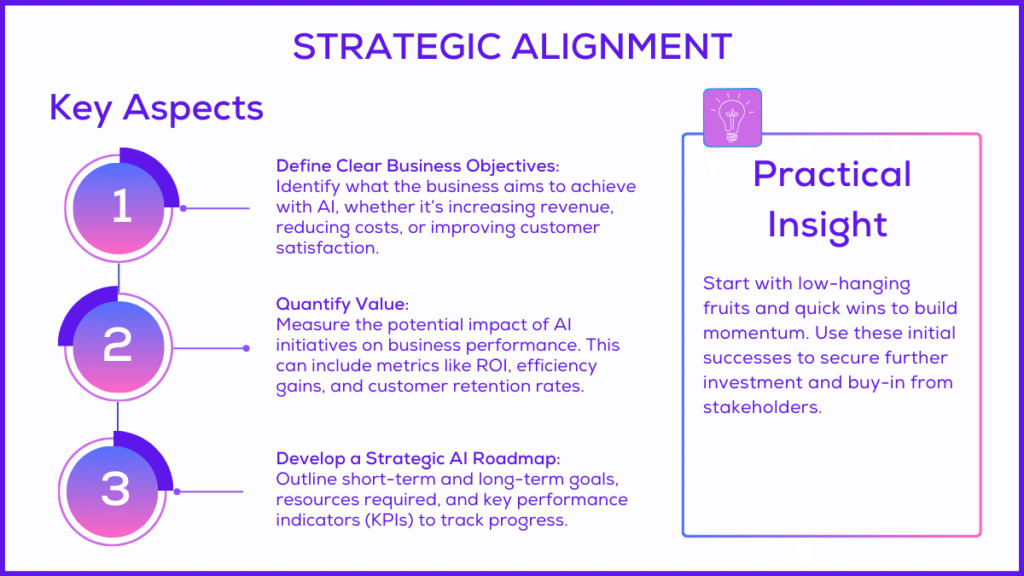
Preparing the Organization for AI
Technology alone doesn’t determine whether an AI project succeeds. An organization’s readiness — across data, processes, and culture — is what makes or breaks delivery. Before investing heavily, leaders should assess where they stand and address gaps early.
Skipping readiness checks leads to costly delays later. In fact, Gartner notes that poor organizational readiness is among the top three reasons AI projects stall before deployment. Addressing these gaps upfront increases the likelihood of moving from proof of concept to full-scale delivery.
Dimensions of Readiness
A structured readiness check covers three core areas:
- Data integrity: Are pipelines clean, reliable, and standardized? Without this, even the best models will underperform.
- Process compatibility: Can existing workflows integrate AI outputs without disruption?
- Cultural alignment: Do teams understand AI’s role and trust it enough to adopt it? Resistance is often cultural, not technical.
Readiness Maturity Framework
Organizations typically fall into one of three tiers:
- Foundational: Early exploration, fragmented data, no governance structures.
- Transitional: Some pilot projects, partial governance, but scaling remains difficult.
- Advanced: Strong governance, integrated pipelines, cross-team collaboration, and continuous optimization.
This framework helps leaders pinpoint where to focus efforts — whether it’s improving data quality, setting governance protocols, or running change management initiatives.
Developing and Deploying AI Solutions
Once the strategy and readiness checks are in place, the real work begins: building, validating, and deploying AI solutions. This stage is where many projects stall, but with the right support, organizations can move efficiently from prototypes to production.
Data Readiness as the Foundation
High-quality data accounts for the majority of AI success. Implementation support focuses on:
- Preprocessing: Cleaning and normalizing data before training.
- Schema alignment: Ensuring different data sources “speak the same language.”
- Anomaly detection: Filtering out errors that could distort results.
Organizations that invest early in data readiness consistently see stronger outcomes and fewer rework cycles.
Iterative Development and Testing
AI thrives on iteration. Instead of building once and shipping, models should be tested, refined, and validated in cycles:
- Prototyping in real-world conditions to expose gaps.
- Validation techniques such as cross-validation to ensure generalizability.
- Stress testing for edge cases and extreme scenarios.
This approach prevents overfitting and ensures systems can handle diverse, unpredictable inputs.
Scalable Infrastructure Setup
AI requires flexible infrastructure that can scale up during peak workloads and scale down to control costs. Effective setups include:
- Cloud-native orchestration (e.g., Kubernetes) for dynamic resource allocation.
- Latency optimization to keep response times fast, especially in real-time applications like fraud detection.
- Observability dashboards that track performance, cost, and reliability.
Organizations leveraging dynamic orchestration have reported significant reductions in infrastructure costs alongside better uptime.
Phased Rollouts for Lower Risk
Rather than deploying across the enterprise at once, phased rollouts help catch issues early.
- Start small, in one department or workflow.
- Monitor performance closely.
- Scale gradually once results are stable and adoption is positive.
This minimizes disruption and builds trust in the system.
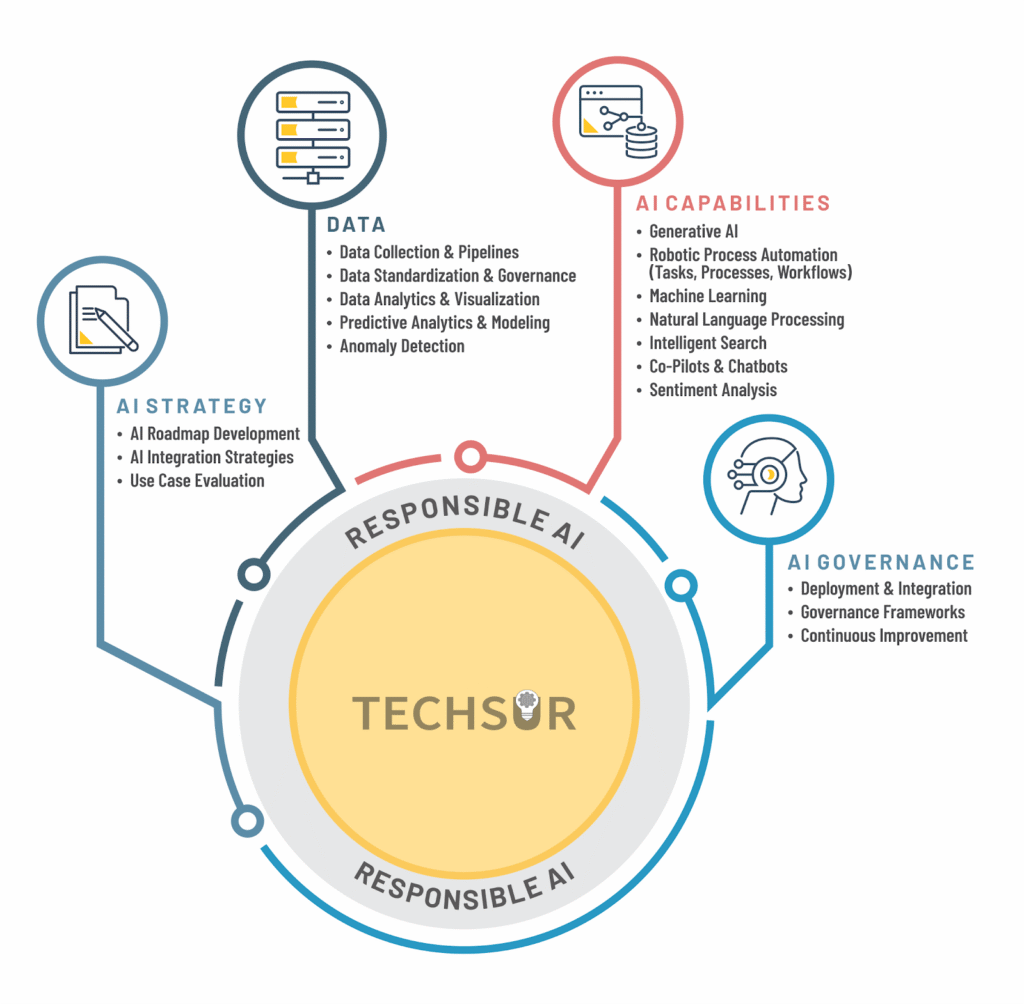
Driving Adoption Through Collaboration and UAT
Even the most advanced AI model fails if teams don’t use it. Adoption depends on collaboration between technical and business stakeholders and rigorous testing with real end users before full deployment.
Cross-Functional Collaboration
AI projects succeed when technical precision meets business insight. Implementation support helps by:
- Defining roles with clarity: Using frameworks like RACI (Responsible, Accountable, Consulted, Informed) prevents confusion during delivery.
- Embedding business experts early: End users and domain specialists should shape how the AI works, not just test it at the end.
- Aligning incentives: Both IT and business units should be measured on project outcomes, not isolated goals.
When collaboration is structured, projects avoid misaligned objectives and gain faster approvals.
User Acceptance Testing (UAT) in Context
Traditional UAT often checks whether the system “works.” For AI, it must go further — verifying if the solution fits real-world workflows. Best practices include:
- Scenario-based testing: End users simulate real tasks (e.g., compliance officers testing multi-jurisdiction cases).
- Iterative feedback loops: Feedback isn’t a one-time exercise; it should continuously refine the model.
- Capturing adoption barriers: Resistance may stem from usability, trust, or training gaps — UAT uncovers these early.
Building Trust Through Feedback
When users see their feedback reflected in the AI’s evolution, trust grows. In practice, this might mean:
- Customer service teams helping refine chatbot responses.
- Compliance teams stress-testing an AI against complex regulatory scenarios.
- Operations teams validating that outputs align with frontline realities.
This active involvement turns skeptics into advocates and smooths adoption across the organization.

Image source: collibra.com
Continuous Improvement and Scaling
AI is not a one-time deployment. Models degrade, data shifts, and regulations evolve. To keep delivering value, organizations need a framework for ongoing optimization and responsible scaling.
Performance drift happens when models encounter new data that differs from training inputs. Without monitoring, accuracy declines quietly over time. Implementation support ensures:
- Automated monitoring: Dashboards track accuracy, latency, and error rates.
- Adaptive retraining: Models are refreshed when performance drops below thresholds.
- Balanced thresholds: Preventing over-retraining (resource waste) or under-retraining (accuracy loss).
- User feedback loops: Input from frontline staff helps refine models to match real-world conditions.
This creates a living system that evolves with the business.
Scaling AI Across the Organization
Scaling isn’t just about rolling out AI everywhere — it’s about doing so responsibly:
- Phased scaling: Expand from one department to multiple units after proven success.
- Cross-functional alignment: Ensure priorities are consistent across teams to avoid siloed AI solutions.
- Data interoperability: Harmonize formats across legacy systems to prevent fragmentation.
- Governance at scale: Tiered oversight ensures low-risk use cases move fast, while high-risk projects get deeper review.
Ethics and Compliance at Scale
The larger AI deployments grow, the higher the stakes for transparency and accountability. Scaling requires:
- Explainability protocols: Decisions must be auditable for regulators and stakeholders.
- Dynamic compliance layers: Systems should adapt to evolving laws (e.g., EU AI Act).
- Embedding trust as default: Explainable outputs and audit-ready trails reduce resistance and speed adoption.
When done correctly, scaling transforms AI from a series of pilots into an enterprise-wide capability that supports efficiency, compliance, and innovation.
Advanced Considerations
For organizations already running AI projects, the next challenge is addressing the deeper issues that surface as systems mature. These often revolve around interoperability and explainability.
Data Interoperability with Legacy Systems
Many enterprises still operate on fragmented legacy platforms. Without harmonization, AI projects risk stalling. Key practices include:
- Schema harmonization: Standardizing formats across disparate systems.
- API-first integration: Using middleware to connect legacy systems with modern AI pipelines.
- Incremental rollout: Testing integrations department by department before scaling enterprise-wide.
Explainability and Transparency Frameworks
As AI adoption grows, regulators and stakeholders are demanding clear explanations for AI-driven outcomes. Best practices include:
- Explainable AI (XAI) techniques: Tools like SHAP to make decisions understandable to non-technical stakeholders.
- Sentence-level citations: Linking outputs back to their data source to build trust.
- Audit-ready documentation: Creating evidence packs for regulators as part of the workflow.
Organizations that embed explainability early not only reduce compliance risks but also build confidence among users and customers.
Leveraging the CustomGPT.ai Solution Partner Program
AI delivery is complex, and many organizations choose to work with certified experts to accelerate success. The CustomGPT.ai Solution Partner Program was designed to provide that level of support — connecting businesses with trusted implementation partners who specialize in planning, deploying, and scaling AI systems.
Through the program, organizations gain access to:
- Specialized expertise across industries and use cases.
- Proven implementation frameworks that reduce risk and shorten time-to-value.
- Ongoing optimization to ensure AI systems evolve alongside business needs.
By working with certified partners, companies move beyond trial-and-error and into structured, results-driven adoption. For leaders focused on success rates and sustainable outcomes, this program offers a clear path forward.
FAQs
What is AI implementation support?
AI implementation support is the professional services layer that helps organizations move from concept to successful deployment. It covers planning, integration, governance, and continuous optimization — ensuring AI projects deliver measurable outcomes instead of stalling at the pilot stage.
What does AI implementation support include?
Comprehensive support typically includes:
Strategy and roadmap development.
Data readiness assessments and integration.
Model development, validation, and testing.
Deployment with phased rollouts.
Monitoring, retraining, and optimization.
Change management and user adoption support.
How much does AI implementation support cost?
Costs vary depending on project scope and complexity. Smaller pilots may cost in the low six figures, while enterprise-scale deployments can run higher. The return on investment often comes from reduced delays, faster adoption, and measurable gains in efficiency, compliance, or revenue.
How long does AI implementation take?
Timelines depend on readiness and project scope. A well-scoped pilot can be delivered in 8–12 weeks, while full enterprise rollouts often take 6–12 months. Organizations with strong governance and data practices typically move faster.
What are common AI implementation challenges?
The most frequent barriers include:
Poor data quality or fragmented pipelines.
Lack of clear business objectives.
Limited cross-functional collaboration.
Inadequate governance and compliance frameworks.
Organizational resistance or lack of adoption.
Implementation support addresses these challenges by providing structure, expertise, and accountability at every stage of delivery.
Conclusion — Ready to Get Started
AI projects rarely fail because of the technology — they fail because organizations underestimate what it takes to deliver them successfully. Structured support turns that risk into opportunity, guiding teams through strategy, governance, deployment, and continuous improvement.
With the right approach, AI moves from proof of concept to a reliable driver of efficiency, compliance, and innovation. Your organization already has the vision — now it’s about turning that vision into results.
2025 is the year to move beyond pilots and start building AI systems that deliver measurable, lasting impact. The foundations are here. The opportunity is clear. The time to start is now.



